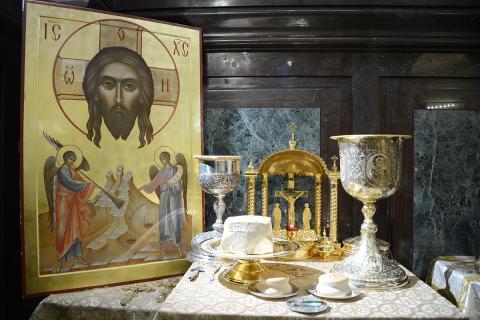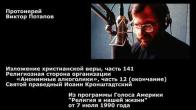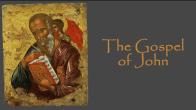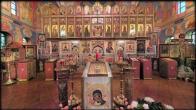You are here
Notes on the Liturgy and the Church.

S.I.Fudel
Chapter 9
During the chanting of the Commandments of the Beatitudes, the central doors, known as the "Royal Doors" (in honor of the Lord "King of Glory") are opened for the 'small entrance." The priest and the deacon, holding the Gospel in his hands, go from the Altar Table, onto the Ambo through the "North" (i.e. left) door. This signifies and reminds us of Christ's setting out to preach. "Jesus came to Galilee, preaching the Gospel of the Kingdom of God" (Mark 1: 14).
The candle carried before the Gospels represents John the Baptist, who was the Lord's "forerunner," and the "candlestand of the light." Christ's setting out to preach is realized - now no longer as a symbol - in the Liturgy several minutes after the 'small entrance" with the reading of the Word of God - the Epistles and the Gospels. In the Liturgy, we contemplate and reflect on the Savior's entire life. Metropolitan Nicholas Cabasilas of Thessalonika writes, "In the Liturgy, we contemplate Christ, Who is depicted in it, and His works and His Passion.
For through the Psalms, readings, and priestly actions and rites the Savior's caring over us is revealed... and it is a mystical process, as it were a single delineation of the single Body of the Savior's life, affording a vision of every part of that life from beginning to end, so that comprehension of that life might illumine our souls and make them worthy of receiving the Holy Gifts. And as that Body had then resurrected all creation, so it now makes the soul reflecting upon it better, and vouchsafes unto it the greater, most divine, spiritual gifts."
According to the Apostle, the Body of the Savior is the Church. This means that the Liturgy, as the "delineation of the single Body of the Savior's life" is the delineation of the Church. Before we hear the actual reading of the Word of God, the choir sings the "Holy God," or the "Trisagion." According to tradition, in the 5th Century, a young boy in Constantinople heard that prayer sung by the Angels. During the reading of the Epistle, the priest prays silently, or "in secret," that in our hearts should shine forth the incorruptible light of divine understanding of the Word of God.
To the Saints, that light was not an allegorical one, but a true light. A certain spiritual struggler told of a vision he experienced in the church: "When… the Apostolic teaching had been read, and the deacon came out to read the Gospel, I saw the church roof opened up, the sky was visible, and each word of the Gospel was like a fire ascending to the Heavens." In antiquity, the priest uttered no secret prayers, i.e. all of the prayers read by the priest were read aloud. The people, of whom the Church is comprised, participated in all of the prayers.
Archimandrite Cyprian wrote, "Contemporary liturgical practice sees the mystical ones (prayers - S.F.) as 'secret"… it was not so in antiquity… Chrysostom clearly teaches us that the priest performs the prayers together with the people… In secretly reading prayers the Church…. deprives the faithful people of participating in conscious Eucharistic life." In antiquity, the people chanted all of the prayers. It was only in the 4th-5th Centuries that special "chanters," choristers separated from the people, began to take on an ever-greater role in chanting…. The exclamation "Wisdom, let us attend," or simply "Wisdom," uttered at this and other points in the Liturgy, represents a call for the faithful to be particularly attentive. "Aright" means "let us stand up straight, piously."
The Hebrew word "Alleluia" generally means "praise ye the Lord," but "beyond that literal meaning, it is a kind of untranslatable joyous exclamation and celebration of praise." Blessed Augustine considered neither the "Amen," nor the "Alleluia," heard in Heaven by the Apostle John (See: Revelation 19: 1), capable of being translated, as they are ineffable. Let us once again bring to mind Chapter 3 of the Apocalypse: "And the Angel of the Church of the Laodiceans write: These things saith the Amen, the faithful and true witness…." There the word "Amen" became as it were the personal Name of the Son of God. In the Church, great significance is attached to understanding of a name. For someone living in love for Jesus Christ, His Name is He Himself, in the sense of His work of grace within those who call upon Him from the heart. The Name of God, called upon with love, immediately responds to the caller with a ray of God's love.
St. Hermas states in The Pastor, "The Name of the Son of God is great and immeasurable, and holds and supports the entire world." That same teacher of the Church called the Church a "tower;" "the Name of God is a mighty Tower." (Proverbs 18: 10). This is why the Priest Pavel Florensky said that "the Name of God is the mystical Church." The Name of God is "God's outline," "the sun in a little drop of water," the sun gathered up in that drop because of love in the Christian heart. But as we can see the relationship of the Name to God being so named, we can perceive a like relationship in human names. We should respond to them as we would to the individuals themselves. To us, those names are also mystical "outlines" of some specific souls in need of our love. For that reason, great importance is attached to the reading the names of people, both living and deceased, in the Liturgy.
Every particle [of bread from the prosphora] removed for them will be immersed in the Blood of the Lord unto purification and life eternal. With how much love and trepidation over someone else's fate should we treat these sometimes-worn scraps of paper bearing names of people often no longer remembered by anyone on earth. In this lies the undying memory of the Church, God's eternal memory, His love and the gathering up within it of all humanity. Recently, while reading the commemoration lists in the Altar, I read the following, "For the salvation of all people, blood relatives, relatives, known and unknown, the ill Lydia and all who are ill."
The names read at the Liturgy are uttered in close proximity to the Table of Oblation and the Altar Table, on which rest the as-yet un-sanctified Holy Gifts. Venerable St. Theognost wrote, "The Holy Gifts, which are yet to be sanctified, lie uncovered after the Symbol of Faith, for the reason that in some way they as it were pray for those who are offering [them] and call out with ineffable voices to the One Living in the heavens, that he not disregard them…. remembering His Son's voluntary exhaustion, ineffable condescension and man-loving sacrifice for us sinners."
PARISH LIFE
RECENT VIDEOS
Address of our Cathedral
Subscribe to our mailing list
While all the materials on this site are copyrighted, you may use them freely as long as you treat them
with respect and provide attribution on the Russian Orthodox Cathedral of St.John the Baptist of Washington DC.









